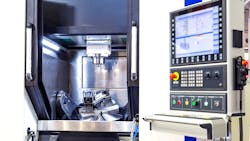Many manufacturers are relying more frequently on a flexible manufacturing systems (FMS) to achieve higher production rates with less downtime and lower changeover costs. These systems require very user-friendly and flexible motor and variable speed drive (VFD) configurations so that engineers can perform a changeover in short order.
Often customers demand fast turnaround and short delivery times to meet the demands of the market. In a very competitive market, such as we have seen recently, the voice of the customer (VOC) increasingly demands that flexible manufacturing do more with less.
With each new product launched, manufacturers feel the pressure to invest in more flexible equipment such as computer-numerical-control (CNC) machining centers for machining prismatic parts and/or robotic material-handling equipment that can perform multiple processing tasks on a range of products.
One of the ways that manufacturers are achieving this is through utilizing motor-and-drive configurations that allow for rapid changeover and new configurations as needed.
The goal is to be able to design systems that can quickly be changed over so we can respond accordingly. A benefit of this type of flexibility in manufacturing is that it becomes possible to explore different processing sequences by rearranging system configurations. What we are striving for are new configurations that will give us the most quantity of parts at the best quality with the lowest possible cost while being responsive to rapidly changing products or setups.
Learning how motors and drives can be configured is key to maintaining flexibility in the manufacturing environment. No longer are we bound by stand-alone, hardwired relay panels to achieve precision control of our automation. Some manufacturers of industrial drives are offering tools such as all-compatible variable-speed drives that share common software platforms, tools, user interfaces and options that allow users to utilize any size drive within the drive portfolio. Once the drive platform is understood, users have a wide range of options to choose from and can quickly scale up or down as needed. This can save time as the project grows and develops.
Selecting the right drive is important for getting the best performance out of our electric motors. The VFD provides control over elements of the motor such as torque, direction, speed and horsepower. Once we have established the correct drive for our application, we must understand how to configure that drive for the motors we’ll be utilizing.
Many options exist, and, depending on our application, we can configure the drives and motors as needed for the current setup without being limited to a single setup or the initial setup configuration. We can reconfigure as needed according to the production demands of our customers.
Variable-frequency drives and motors can be configured intelligently for energy efficiency and effectiveness across many platforms. Formerly, a VFD and motor was a one-to-one affair, but VFDs can be configured to run multiple motors, thus reducing energy consumption and saving time, money and space inside of the control cabinet.
It’s not uncommon to have a VFD run multiple motors in each application as they are needed. Depending on power consumption and rate of usage, we can realize a wider range of options, which allows us to take full advantage of the space and power we have available.
A basic configuration for a drive and motor is power coming into a drive and that power being converted and controlled in such a manner to give control over the rpm of a motor. The motor can have an application, such as controlling a hydraulic pump or be a motor for a water pump to fill or maintain a level in a tank or it could be a spindle motor on a CNC machining center.
In the machining industry, drives and motors are utilized to achieve control over spindle rpm and machine movements so we can precisely control how to cut metal to produce a given part.
A classic example is a CNC spindle drive, which allows for variation in rpm called “speeds” and in driven ballscrews to move the table, also known as feed rate or “feeds.” The x and y axes of the machine are controlled using a VFD and the motor through a programmable logic controller (PLC) so that the feed rate desired for a given cut is achieved.
A typical setup in a CNC control panel will have two VFDs that control the motors in the machining system. One VFD will control the spindle motor maintaining the rpm as requested per the G-code program. The other VFD can control the x, y and z axes for table and head motions during the machining process.
On less expensive units or where space is at a premium inside the control panel, there will be one VFD only to control all the motors. The risk is, if a capacitor were to expire, the whole system would be down. On higher-end units we will typically see one VFD for the spindle motor, one VFD for the x and y axes and one VFD for the z axis. This configuration is more reliable over the lifetime of the machine.
Variable-frequency drives and motors play an important part in the day-to-day operation of automation systems. Whether we utilize them in broad systems with a multitude of operations or in simple applications to achieve a single process, drives and motors will always be the backbone of motion control.
The automation control designer understands that learning how to configure motors and drives to achieve the best outcome for their processes sets them apart from the crowd and is the key to success in automation systems.
About the Author
Andy Watkins
Contributing Editor
Andy Watkins is direct sales manager at Romi Machine Tools in Erlanger, Kentucky. Contact him at [email protected].

Leaders relevant to this article:

